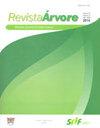南亚马逊河流域森林地层土壤根状生物量和有机碳
IF 0.8
4区 农林科学
Q4 FORESTRY
引用次数: 1
摘要
亚马逊地区的土壤,尽管是世界上最茂密的森林之一,但主要特征是养分有效性低,凋落物是养分进入的主要途径。本研究的目的是量化一年中旱季和雨季细根生物量,包括土壤有机碳,并比较不同研究环境下的结果。该研究是在humait本文章由计算机程序翻译,如有差异,请以英文原文为准。
RADICULAR BIOMASS AND ORGANIC CARBON OF THE SOIL IN FOREST FORMATIONS IN THE SOUTHERN AMAZONIAN MESOREGION
ABSTRACT The soils of the Amazon region, despite being under one of the densest forests in the world, are mostly characterized by the low availability of nutrients, with litter being the main route of nutrient entry. The objective of this study was to quantify the biomass of fine roots in the dry and rainy seasons of the year, including the organic carbon of the soil, and to compare the results in different study environments. The study was carried out in environments of native forest and reforestation aged over 20 years, located in the municipality of Humaitá – AM state. To assess the root biomass, collections were carried out in two periods of the year: dry and rainy seasons. In each of the study areas, five trenches, 0.40 m deep by 0.40 m wide, were dug manually at depths of 0-5, 5-15, and 15-30 cm. For the organic carbon analysis, soil samples were collected in the form of clods at the same depths. The production of root biomass in the native forest environment occurred more intensely in the rainy season, reaching values of 8.19 t. ha-1, greater than 3.57 t. ha-1 found in reforestation. The density as a function of the soil volume showed that the highest concentration is found in the first 5 centimeters of depth, differing significantly in the 5-15 and 15-30 cm layers for native forest area. The organic carbon of the soil showed significance between the dry and rainy seasons for the natural forest environments and reforestation with genipap.
求助全文
通过发布文献求助,成功后即可免费获取论文全文。
去求助
来源期刊

Revista Arvore
FORESTRY-
CiteScore
1.00
自引率
0.00%
发文量
32
审稿时长
4-8 weeks
期刊介绍:
A Revista Árvore é um veículo de comunicação científica da Sociedade de Investigações Florestais – SIF. O jornal é de acesso gratuito, revisado por pares, que publica bimestralmente trabalhos científicos originais no campo da Ciência Florestal. As áreas temáticas para publicação são: Ambiência e Conservação da Natureza, Manejo Florestal, Silvicultura e Tecnologia da Madeira e Utilização de Produtos Florestais.
A política editorial visa manter alta conduta ética em relação à publicação e aos seus funcionários, rigor na qualidade dos artigos científicos, seleção de revisores qualificados, respeito profissional aos autores e processo de tomada de decisão imparcial. A Revista Árvore publica artigos apenas em inglês.
Artigos de revisão podem ser publicados se houver uma discussão relevante resumindo o estado da arte sobre o assunto. A revisão estrita da literatura não é aceita.
 求助内容:
求助内容: 应助结果提醒方式:
应助结果提醒方式:


